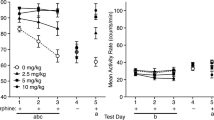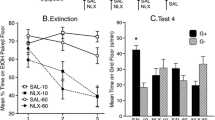Abstract
The issue of whether tolerance develops to the motivational effects of opioids was addressed by use of an unbiased place preference conditioning procedure. Administration of the μ-opioid agonists morphine or fentanyl produced dose-related preferences for the drug-associated place in control rats. In contrast, the κ-opioid agonist, U-69593 produced conditioned place aversions. Non-contingent administration of morphine (5.0 mg/kg/12 h) for 4 days prior to conditioning resulted in tolerance to its reinforcing effects, and cross-tolerance to the effects of fentanyl. No cross-tolerance to the motivational effects of the psychostimulantd-amphetamine or the κ-opioid agonist U-69593 was observed. Chronic administration of U-69593 prior to conditioning produced tolerance to its aversive effects. This treatment did not, however, modify the reinforcement produced by morphine. These data demonstrate that tolerance develops to both the reinforcing and aversive properties of opioids and suggest that differential cross-tolerance may provide a useful method for determining the pharmacological basis underlying drug-induced motivational effects.
Similar content being viewed by others
References
Bozarth MA, Wise RA (1981) Heroin reward is dependent on a dopaminergic substrate. Life Sci 35: 1881–1886
D'Amour FE, Smith DL (1941) A method for determining loss of pain sensation. J Pharmacol Exp Ther 72: 74–79
Emmett-Oglesby MW, Shippenberg TS, Herz A (1988) Tolerance and cross-tolerance to the discriminative stimulus properties of fentanyl and morphine. J Pharmacol Exp Ther 245: 17–23
Iwamoto E (1986) Place-aversion conditioned by phencyclidine in rats: development of tolerance and pharmacological antagonism. Alcohol Drug Res 6: 265–276
Jaffe JH (1985) Drug addiction and drug abuse. In: Gilman A, Goodman LS, Rall TW, Murad F (ed) The pharmacological basis of therapeutics. MacMillan, New York Toronto London, pp 532–581
Johanson CE, Schuster CR (1981) Animal models of drug self-administration. In: Advances in substance abuse. JAI Press, New York, pp 219–297
Kalant H, Leblanc AE, Gibbins RJ (1971) Tolerance to, and dependence on, some non-opiate psychotropic drugs. Pharmacol Rev 23: 135–191
Lahti RA, Mickelson MM, McCall JM, Von Voigtlander PF (1985) [3H]U69593, a highly selective ligand for the opioid κ-receptor. Eur J Pharmacol 109: 281–284
Litchfield JT, Wilcoxon F (1949) A simplified method of evaluating dose-effect experiments. J Pharmacol Exp Ther 96: 99–112
Martin WR, Sloan JW (1977) Neuropharmacology and neurochemistry of subjective effects, analgesia, tolerance and dependence produced by narcotic analgesics. In: Martin WR (ed) Drug addiction. Springer, Berlin Heidelberg New York, pp 43–158
McAulife WE, Gordon RA (1974) A test of Lindesmith's theory of addiction: the frequency of cuphoria among long term addicts. Am J Sociol 79: 795–840
McCown TJ, Barrett RJ (1980) Development of tolerance to the rewarding effects of self-administeredS(+)-amphetamine. Pharmacol Biochem Behav 12: 137–141
Mirin SM, Meyer RE, McNamee HB (1976) Psychopathology and mood during heroin use. Arch Gen Psychiatry 33: 1503–1508
Mucha RM, Herz A (1985) Motivational properties of kappa and mu-opioid receptor agonists studied with place and taste preference conditioning procedures. Psychopharmacology 82: 241–245
Pfeiffer A, Brantl V, Herz A, Emrich HM (1986) Psychotomimesis mediated by κ-opioid receptors. Science 233: 774–776
Schuster CR, Balster RL (1977) The discriminative stimulus properties of drugs. In: Thompson T, Dews PB (eds). Advances in behavioural pharmacology 4. Academic Press, New York, pp 85–138
Shannon HE, Holtzman SG, (1976) Evaluation of the discriminative effects of morphine in the rat. J Pharmacol Exp Ther 198: 54–65
Shippenberg TS, Herz A (1986) Differential effects of μ- and κ-opioid agonists on motivational processes. NIDA Res Monograph 75: 563–566
Shippenberg TS, Herz A (1987) Place preference conditioning reveals the involvement of D1-dopamine receptors in the motivational properties of μ- and κ-opioid agonists. Brain Res 436: 169–172
Siegel S (1973) Morphine analgesia tolerance: its situation specificity supports a Pavlovian conditioning model. Science 193: 323–325
Siegel S (1978) Tolerance to the hyperthermic effect of morphine in the rat is a learned response. J Comp Physiol Psychol 6: 1137–1149
Siegel S, MacRae JM (1984) Environmental specificity of tolerance. Trends Neurosci 7: 140–143
Spyraki C, Fibiger HC, Phillips AG (1982) Dopaminergic substrates of amphetamine-induced place preference conditioning. Brain Res 253: 185–193
Stolerman IP (1985) Motivational effects of opioids: evidence on the role of endorphins in mediating reward or aversion. Pharmacol Biochem Behav 23: 877–881
Tiffany ST, McCal KJ, Maude-Griffin PM (1987) The contribution of classical conditioning to tolerance to the antinociceptive effects of ethanol. Psychopharmacology 92: 524–528
Way EL, Loh HH, Shen FH (1969) Simultaneous quantitative assessment of morphine tolerance and physical dependence. J Pharmacol Exp Ther 167: 1–8
Woods JH, Young AM, Herling S (1982) Classification of narcotics on the basis of their reinforcing, discriminative, and antagonist effects in rhesus monkeys. Fed Proc 41: 221–227
Woolverton WL, Cervo L, Johanson CE (1984) Effects of repeated methamphetamine self-administration in rhesus monkeys. Pharmacol Biochem Behav 21: 737–741
Young AM, Woods JH, Herling S, Hein DW (1983) Comparison of the reinforcing and discriminative stimulus properties of opioids and opioid peptides. In: Smith JE, Lane JD (eds) The neurobiology of opiate reward processes. Elsevier, Amsterdam, pp 147–174
Author information
Authors and Affiliations
Rights and permissions
About this article
Cite this article
Shippenberg, T.S., Emmett-Oglesby, M.W., Ayesta, F.J. et al. Tolerance and selective cross-tolerance to the motivational effects of opioids. Psychopharmacology 96, 110–115 (1988). https://doi.org/10.1007/BF02431542
Received:
Revised:
Issue Date:
DOI: https://doi.org/10.1007/BF02431542




